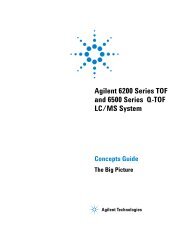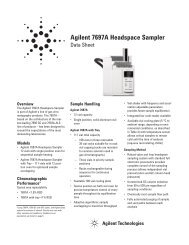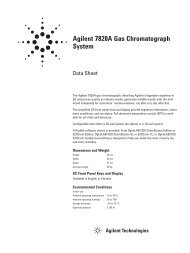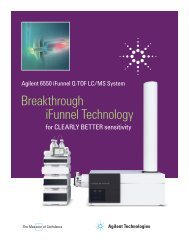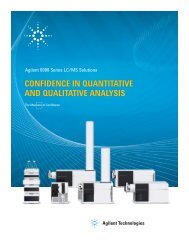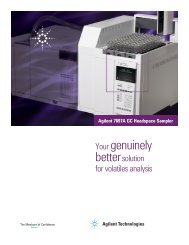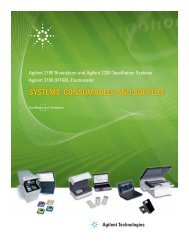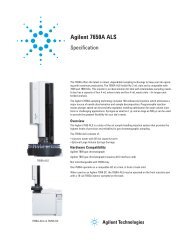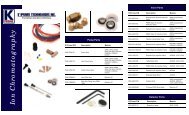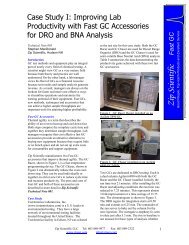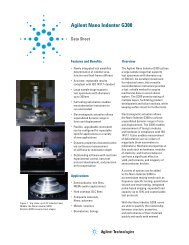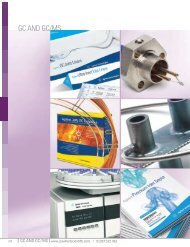Agilent 7000B Triple Quadrupole GC/MS - K'(Prime) Technologies
Agilent 7000B Triple Quadrupole GC/MS - K'(Prime) Technologies
Agilent 7000B Triple Quadrupole GC/MS - K'(Prime) Technologies
Create successful ePaper yourself
Turn your PDF publications into a flip-book with our unique Google optimized e-Paper software.
A collision cell optimized for <strong>GC</strong> applications<br />
Extractor Source<br />
w/Ramped Iris Detector<br />
Because the multiple reaction monitoring (MRM) process essentially eliminates<br />
all chemical noise, neutral noise from the highly energetic metastable helium<br />
is the primary <strong>GC</strong>/<strong>MS</strong>/<strong>MS</strong> noise source. <strong>Agilent</strong> engineers started with the<br />
proven collision cell design of the 6400 Series LC/<strong>MS</strong>/<strong>MS</strong> and retuned the<br />
dimensions and voltages for <strong>GC</strong> applications. They also added a novel helium<br />
quench gas technology, in which a small, supplemental flow of helium is mixed<br />
with nitrogen collision gas. This allows highly efficient dissociation, rapid refocusing<br />
of product ions, rapid clearance of the cell (for zero cross-talk)—as well<br />
as significant reduction of neutral noise.<br />
Standard Source<br />
& Detector mode<br />
New EI source and detector boost <strong>MS</strong> sensitivity.<br />
Sensitivity is improved across the entire mass range<br />
for even lower limits of detection.<br />
Measured collision cell clearing time less than 1 msec ensures zero cross-talk<br />
between transitions. (Ask for a copy of AS<strong>MS</strong> 2009 Poster MPZ 656: High Speed<br />
Quantitative <strong>GC</strong>/<strong>MS</strong>/<strong>MS</strong> Data Acquisition.)<br />
Dwell Time (msec) 10 5 3 2 1<br />
# Transitions 18 33 50 66 99<br />
Cycle Time 198 198 200 198 198<br />
MRM/sec 91 167 250 333 500<br />
n 10 10 10 10 10<br />
Average Area 37686 37673 37465 36887 35180<br />
SD Area 940 1925 1439 1557 1447<br />
% RSD 2.5% 5.1% 3.8% 4.2% 4.1%<br />
Precision, precision, precision.<br />
Sensitivity without precision can result in unacceptable<br />
MRM ratios and poor quantitation results. As<br />
<strong>MS</strong>/<strong>MS</strong> baseline noise approaches zero, signal-tonoise<br />
ratio (S/N) becomes almost meaningless as a<br />
measure of performance; under ultra-low noise conditions,<br />
RSD<br />
of peak response is a better benchmark. The <strong>7000B</strong><br />
delivers the essential precision that you need to<br />
make accurate qualitative and quantitative decisions,<br />
even at dwell times as low as 1 or 2 msec.<br />
To learn more about the <strong>Agilent</strong> <strong>7000B</strong> <strong>Triple</strong> <strong>Quadrupole</strong> <strong>GC</strong>/<strong>MS</strong>, visit www.agilent.com/chem/<strong>7000B</strong>. 7



